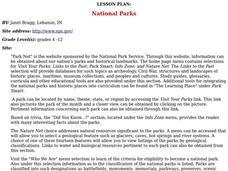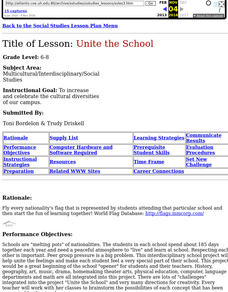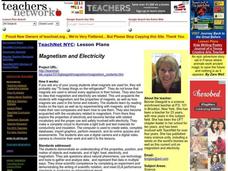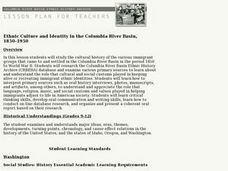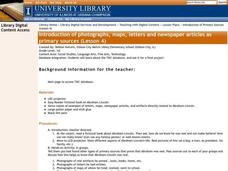Curated OER
Multiplication Tables Using Microsoft Excel
Eighth graders are introduced to Microsoft Excel as a computer application software program. They create multiplication tables in Microsoft Excel. Students work in small groups. They discuss the $ (anchor) function in Microsoft Excel.
Curated OER
Measuring Comprehension in First Graders
Make a prediction! Read The Very Cranky Bear with your first graders, making predictions and asking questions. Consider creating a list of comprehension questions to post while readers are listening to the story. Also consider making a...
Curated OER
Food Comparison PDF
In this health worksheet, students are led through lessons to become familiar with the dietary recommendations of the government.
Curated OER
Brick Memorial Flyer
Students conduct research using the internet, school server and newspapers on the history of the brick memorial for veterans and its developmental process. They create and design a three column page layout for a brochure using Microsoft...
Curated OER
Zoo Poo
Students use Internet research to determine the amount of carbon dioxide produced per unit energy for biomass and coal. In this alternative energy instructional activity, students research to find out how much energy and carbon dioxide...
Curated OER
Bugs-Eye View
Students research different bugs and insects and write letters from bugs' and insects' points of view to humankind.
Curated OER
National Parks
Students conduct research on the U.S. National Parks. They conduct Internet research, analyze maps, and create and solve riddles that present specific clues pertaining to a selected national park and it's location.
Curated OER
Evidence of Climate Change
Sixth graders examine climate change in the state of Colorado. In this climate lesson, 6th graders watch 2 video clips regarding the topic and research the subtopics- snow pack, precipitation, temperature, forest fires, river flow,...
Curated OER
Identify Cultural Influences - Hiawatha
Learners explore Native American life and culture. In this Native American lesson, students watch a video segment pertaining to The Song of Hiawatha, by Henry Wadsworth Longfellow. Learners discuss Native American culture and create...
Curated OER
Unite The School
Learners engage in a school project help unite the feelings and make each student feel a very special part of their school. This project would be a great beginning of the school "opener" for students and their teachers.
Curated OER
Birds Around the Village
Students observe the physical characteristics of birds and identify birds found in their village. They describe characteristics, behaviors and habitats of local birds in this series of lessons.
Curated OER
Magnetism and Electricity
Students demonstrate a comprehension of the properties, position, and motion of objects and materials, and of light, heat, electricity, and magnetism. They use materials to assemble an electric circuit and test materials, including...
Curated OER
Mountain Pine Beetles
Students research and develop power point presentations that answer the question, "What is changing our forests?" In this ecology lesson, students research the niche of Pine Beetles and their increased effect on the forests in Colorado.
Curated OER
Toy Planet
Students design a toy store, supply it with merchandise (on paper) and create advertisements. They also manage the store's debits and credits by using a spreadsheet. They consider how to promote the sale of their merchandise.
Curated OER
Eraser Dog-Divide
In this division worksheet, students divide three and four digit numbers by single digit numbers. On this worksheet, all numbers divide evenly, with no remainder. This worksheet generator allows the teacher to control the set up of the...
Curated OER
Monitoring an Epidemic: Analyzing Through Graphical Displays Factors Relating to the Spread of HIV/AIDS
Tenth graders differentiate pandemic and epidemic. In this health science lesson plan, 10th graders analyze how HIV and AIDS affect different countries. They construct and interpret different types of graphs.
Curated OER
Stories of Individuals in the Chinese Community: a Comparative Approach
Students focus on stories describing the experiences of several individuals in the Chinese community and compare them with the experiences of Chinese immigrants in the late 20th century.
Curated OER
Do You Haiku? We Do!
Third graders try their hands at writing Haiku, a form of Japanese poetry. Haiku is usually 17 syllables in three-line form. This engaging lesson has many excellent worksheets and website imbedded in the plan. They share their finished...
Curated OER
Canada and its Trading Partners
Students identify the relationship between Canada and its trading partners. They use two data sources, Canadian Statistics and E-STAT, on the Statistics Canada website to explore the growing importance of trade in general.
Curated OER
Outside interview
Students refine their fieldwork skill by conducting interviews. From the position of an outsider, they conduct research and interviews. Student interviews are maintained as a part of a portfolio. Interview kits and assessment...
Curated OER
Photoshop for Fifth Graders: the Basics
Students review the basic tools for Adobe Photoshop. In this Photoshop instructional activity, students choose a picture and discuss its properties. Students use tools to see how pictures are altered. Students use layers to change...
Curated OER
Unit Plan Template
Learners research the adaptations of desert animals and build their research skills. In this the adaptations of desert animals activity, students describe major factors that desert animals have on their habitat. Learners explore how to...
Curated OER
Ethnic Culture and Identity in the Columbia River Basin, 1850-1950
Students explore cultural history of immigrant groups that settled in the Columbia River Basin from 1850 to World War II, and examine various primary sources to explore role cultural and social customs played in keeping alive immigrant...
Curated OER
Introduction of Primary Sources
First graders are introduced to photographs and newspaper articles to be used as primary sources. Using a projecter, they are shown photographs of a famous person to prove they were real and not make believe. In groups, they use...








